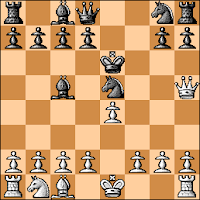Repeating the "comments" that follow a recent blog post (see "Slaughter"):
Guido De Bouver said...
8...Qf6 seems like a killer black reply in the position you described ? [after 1.e4 e5 2.Nf3 Nc6 3.Bc4 Bc5 4.Bxf7+ Kxf7 5.Nxe5+ Nxe5 6.Qh5+ Ke6 7.Qf5+ Kd6 8.f4]
What has been tried here ?
Rick Kennedy said...
Guido,
You are right, 8...Qf6 is strong for Black. It is at least as old as A.W. Jerome - W. Shinkman, USA, 1874 (0-1, 21).
The Database is somewhat misleading in this regard, as it has 50 games with 8...Qf6, with White scoring 58%.
After 9.fxe5+ Qxe5 The Database has 53 games (it picked up two games with 8...Qe7 and one with 8...Qe8) with White scoring 59%.
White has tried 10.Qxe5+, 10.Qf8+, 10.Qg4, 10.Nc3, 10.c3 and 10.Qf3 with different degrees of success.
10.Qf8+ scores worst (0%, 3 games) and 10.Qg4 scores best (100%, 1 game); with 10.Qf3 being the currently recommended move (71%, 27 games)
This topic certainly deserves a post or two -- and soon! I will get to work on it.
Thanks.
billwall - benstoker
standard game, FICS, 2010
1.e4 e5 2.Nf3 Nc6 3.Bc4 Bc5 4.Bxf7+
4...Kxf7 5.Nxe5+ Nxe5 6.Qh5+ Ke6
7.Qf5+ Kd6 8.f4 Qf6
9.fxe5+
The most recent coverage of the 8...Qf6 line in this blog was in the game axykk - bromby, blitz, FICS, 2011: 9.fxe5+ Qxe5 10.Qxe5+ Kxe5 11.b4 Bb6 12.Bb2+ Kxe4 13.Bxg7 Black resigned
9...Qxe5 10.Qf3
After 10.Qf3, Black has to avoid falling into the "Disdainful Defender Defense", for example, 10...Nf6 11.d3 Rf8 12.Bf4 and the Black Queen is lost. This is one of those apparent "optical illusions" that appear from time-to-time in the Jerome Gambit, and in this case it has accounted for 9 wins for White.
Instead, 10.Qf3 Nf6 22.d3, and as Jerome wrote of his last move in the April 1874 issue of the Dubuque Chess Journal, "Compelling either K or Q to move as White threatens Bf4; or Black can play ...g5" [translated to algebraic notation].
10...Nf6 11.d3 Kc6 12.c3
White has only one pawn for his sacrificed piece, and he is currently behind in developement. He works with what he has available, however: the central "Jerome pawns" and Black's misplaced King. Something will come up (see "Like the Big Boys").
12...Re8 13.b4 Bb6 14.Bf4 Qh5 15.a4 d5 16.Nd2
16...Bg4 17.Qg3 dxe4 18.d4 e3 19.Nc4 Qf5 20.0-0 Nh5
21.Nxe3 Nxg3 22.Nxf5 Nxf5 23.b5+ Kd5 24.a5 Nxd4 25.axb6 Ne2+ 26.Kh1 Nxf4 27.Rxf4 axb6 28.Rb1 Be6 White resigned
Wait a minute... White resigned?
Yes, good Readers, it is true. Losses by Bill Wall in The Database are rarer than hens' teeth, but they occasionally happen. (Cherish this one; you will probably not see another.)
Every once in a while I have to point out that the Jerome Gambit is, "officially", a refuted opening – no matter how many times we win with it!












